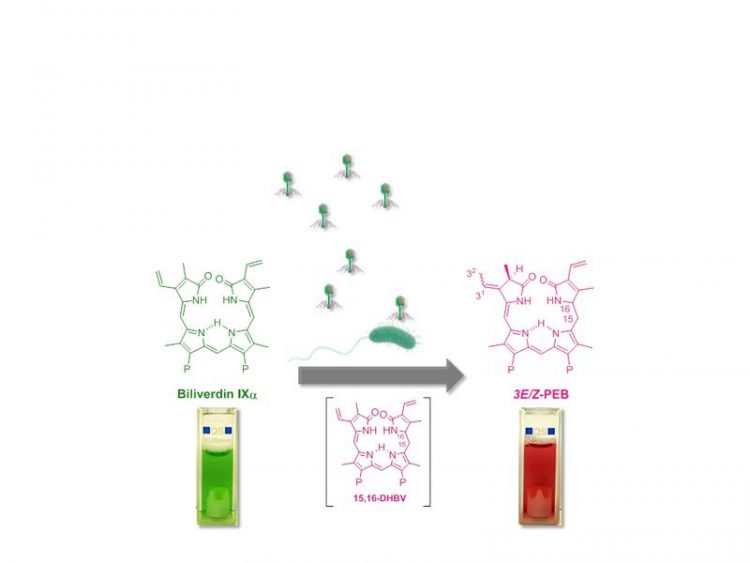Viruses cause bacteria to produce pink pigments

Viruses from the ocean carry the genetic information for the turnover of the green pigment biliverdin to the pink pigment phycoerythrobilin.
Plants use certain colour pigments in order to convert light into energy by way of photosynthesis. They allow plants to gather light energy. This also works in a similar way for microbes, for instance cyanobacteria.
The fact that a very large number of viruses are able to contribute towards pigment production has now been demonstrated by biologists from the University of Kaiserslautern with a colleague from Israel. The viruses introduce genetic material into the bacteria which then allows them to produce the pink-coloured pigments. The study has now been published in the renowned scientific journal ‘Environmental Microbiology’.
Cyanobacteria (also known as blue-green algae) and other oceanic bacteria are able to convert carbon dioxide and water into carbohydrates and oxygen with the help of sunlight, just like plants. “They use light-harvesting complexes in order to capture the energy from the light,” says microbiology Professor Nicole Frankenberg-Dinkel from the University of Kaiserslautern.
“These consist of proteins and colour pigments.” The latter are also responsible for the characteristic colouration. In the case of plants, for example, this is the green pigment ‘chlorophyll’, in cyanobacteria this is the blue pigment ‘phycocyanobilin’ and the pink pigment ‘phycoerythrobilin’.
“The synthesis of these pigments is already well understood,” the microbiologist adds. “So far researchers have only been able to demonstrate their presence in organisms which release oxygen through the process of photosynthesis.” In addition to this form of conventional photosynthesis performed by plants and cyanobacteria, there are also other variants that do not release any oxygen.
The biologists at Kaiserslautern sought to investigate, together with their Israeli research colleague and bioinformatician Oded Béjà (from the Technion-Israel Institute of Technology), the extent to which pigment synthesis is prevalent in certain marine regions. The biosynthesis of pink pigment ‘phycoerythrobilin’ was the focus of their work.
“The genetic information for the synthesis of the pink pigment is widespread throughout all the world’s oceans,” says the professor. This is where the researchers made a notable discovery: this information is wide spread in viruses.
“The viruses carry genetic information which can be used to produce the pink-coloured pigments,” Frankenberg-Dinkel explains. The viruses introduce this genetic information into bacterial cells which enable them to synthesise the pink pigment. “What is new is that we are able to use bioinformatic analyses to determine the type of viruses which carry this genetic information”, Frankenberg-Dinkel continues. “We were able to show that the viruses most likely affect those microbes for which we do not yet know what purpose the pigment serves.”
For her study, Frankenberg-Dinkel and her team analysed datasets obtained from metagenome databases. “These contain all the genetic information of all the organisms we would usually extract during a field trip at sea, for example,” the researcher explains. “This technique allows us to gain a detailed insight into the ecosystem without having to investigate it on location.”
The biologists from the University of Kaiserslautern work closely with their colleague from the Technion-Israel Institute of Technology in Haifa. This cooperation is funded by the German-Israeli Foundation for Scientific Research and Development.
The study was published in the renowned scientific journal ‘Environmental Microbiology’: Ledermann, B., Beja, O. & Frankenberg-Dinkel, N. (2016) New biosynthetic pathway for pink pigments from uncultured oceanic viruses.
doi:10.1111/1462-2920.13290
For enquiries:
Prof Dr Nicole Frankenberg-Dinkel
Department of Biology
Email: nfranken@bio.uni-kl.de
Tel.: +49 631/205-2353
Media Contact
More Information:
http://www.uni-kl.deAll latest news from the category: Life Sciences and Chemistry
Articles and reports from the Life Sciences and chemistry area deal with applied and basic research into modern biology, chemistry and human medicine.
Valuable information can be found on a range of life sciences fields including bacteriology, biochemistry, bionics, bioinformatics, biophysics, biotechnology, genetics, geobotany, human biology, marine biology, microbiology, molecular biology, cellular biology, zoology, bioinorganic chemistry, microchemistry and environmental chemistry.
Newest articles

A new puzzle piece for string theory research
Dr. Ksenia Fedosova from the Cluster of Excellence Mathematics Münster, along with an international research team, has proven a conjecture in string theory that physicists had proposed regarding certain equations….

Climate change can cause stress in herring larvae
The occurrence of multiple stressors undermines the acclimatisation strategies of juvenile herring: If larvae are exposed to several stress factors at the same time, their ability to respond to these…

Making high-yielding rice affordable and sustainable
Plant biologists show how two genes work together to trigger embryo formation in rice. Rice is a staple food crop for more than half the world’s population, but most farmers…



